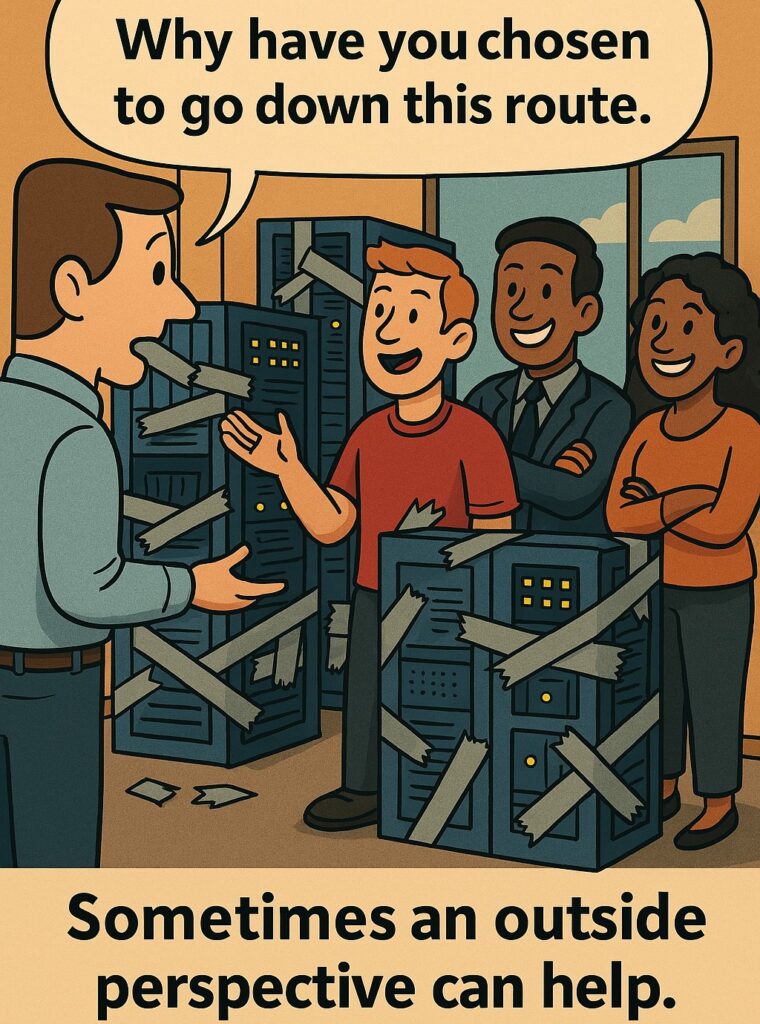The hidden power of a fresh perspective—no matter how smart your team is.

Ever stare at a bug for hours, only for a teammate to glance at it and go, “Oh, you missed a semicolon”?
That moment right there—that’s the power of a fresh set of eyes.
It happens at the micro level (a tricky bug). It happens at the macro level (why is your deploy process so damn manual?). And it happens all the time in engineering orgs that have gone too long without an outside voice.
This post is about that principle: sometimes the fastest way to fix something is to let someone else look at it.
The Bug That Wouldn’t Die
In my first engineering job, I started in QA. One of the first things my director told me stuck with me forever:
“Take your time. Look through everything. Most of our best bugs are reported by new people.”
Why? Because new eyes haven’t normalized the weird stuff yet. They ask “Why is this like that?” instead of “How do I work around this?”
That idea shows up everywhere. Even now, I’ll bang my head against a bug, only to have someone on my team walk over and spot the issue in 10 seconds. Not because they’re better—because they’re not buried in the context.
When You’re Too Close to See It
Every engineering team has its weirdness. The config that only works when deployed in a specific order. The test that always fails the first time but passes on rerun. The manual step nobody documents but everybody knows.
You learn to live with it. You stop noticing it. You adapt.
But when someone new walks in—an external consultant, a new hire, or just a peer from another team—they don’t carry your baggage. They ask the simple questions. The obvious questions. And that’s where the gold is.
“Why are you doing it that way?”
“Is this still needed?”
“Wait, is this step documented anywhere?”
They’re not trying to be clever. They’re just not conditioned to ignore the pain.
It’s Not About Smarts—It’s About Distance
This isn’t about hiring smarter people. It’s about creating space from the problem.
A lot of organizations assume they don’t need outside help because they’ve got smart engineers. And they’re right—smart engineers can absolutely solve big problems.
But being smart isn’t the same as being clear-eyed.
When you’re deep in a system, you’ve made peace with the quirks. You know which wires not to touch. And that makes you efficient… but not always innovative. Sometimes it makes you stuck.
Small Input, Big Unlock
You don’t need a six-month audit or a million-dollar contract to get this benefit.
Sometimes a 30-minute conversation with someone who isn’t in your system can unlock a solution your team has danced around for months.
Sometimes it’s just someone asking:
“Have you tried automating this?”
“Why are two teams solving the same problem separately?”
“Is this failing in prod, or just test?”
“What if you removed this step entirely?”
These questions aren’t magic. But they only get asked by people who aren’t caught in the weeds.
Bring in Eyes, Not Egos
The goal isn’t to embarrass your team or throw shade. It’s to help them see clearly again.
A good external review or consultation feels collaborative, not critical. The best conversations aren’t about proving someone wrong—they’re about lifting the fog and making better decisions.
You can do this by:
- Bringing in consultants for short engagements
- Encouraging inter-team code reviews
- Asking new hires for “first impressions” docs
- Having engineers rotate across domains to offer outside-in feedback
And most importantly: creating a culture where questions are welcomed, not deflected.
Wrap-Up: Step Back. Invite Others In.
If your team is frustrated by slow progress, mystery bugs, or unclear ownership, don’t just push harder.
Sometimes the best move isn’t another sprint—it’s another set of eyes.
Because once you’ve seen a system a certain way for long enough, you stop questioning it. But someone else might walk in, ask a basic question, and suddenly everything clicks.
Bring that person in. Encourage those questions.
Your team already has the skills. Sometimes they just need help seeing the problem.
💡Liked this post?
Get real-world solutions like this in your inbox—join the newsletter.